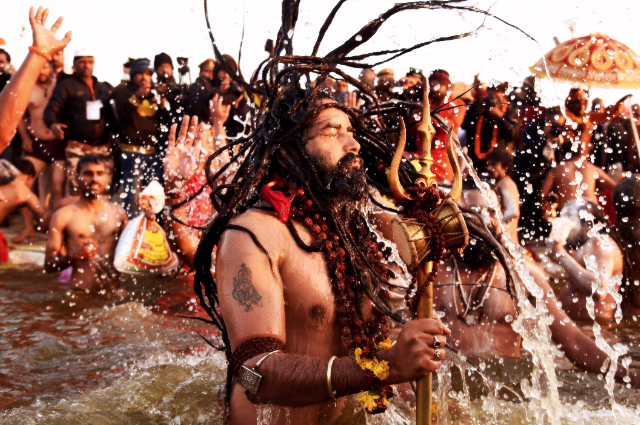This Maha Kumbh Mela was characterized by the newly done initiation of Naga Sadhus out of which over 20% of them were from Dalit and tribal communities. They had travelled from the forests of Chhattisgarh, the villages of Bengal, hills of Arunachal and Tripura and important centers of Madhya Pradesh. As tradition and rituals go for the Naga Sadhus, prior to the initiation, they have left their worldly possessions of occupation, their family ties, and homes to embrace death through the ritual reserved for the departed, the Pind Daan, in which they perceive and are perceived through their spiritual pursuits. Naga Sadhus perform the Pind Daan while they’re still alive; hence, Naga Sadhus are not cremated. They are buried after death, instead. As they only become Naga Sadhus after performing the Pind Daan. The Pind Daan and Mukhagni are not performed by them during physical death; they are either given Bhu or Jal Samadhi.
The Naga Sadhus are seen as a spectacle of life with its many mysteries, their origins are woven into the history and the battles of northern India, from ascetic mercenaries and warriors to ascetic saints that belong to different Hindu monastic orders, specifically the Shaiva and Vaishnava sects.
In the duration of the Kumbh Mela, the Naga Sadhus have displayed their spiritual dedication and tradition, as well as their practiced mastery over their weaponry which had transfixed those gathered at the banks of Triveni. They also led most of the Akharas during the Amrit Snan. This year’s Maha Kumbh was painted and garnished by their spirit and visual grandeur brought by the flowers in their hair, and bright garlands around their neck, as well as the Trishuls held high by them. In addition to all of this, around 250 women have chosen the path of the Naga Sadhvis.
There are five Parva days which are reserved for sacred bathing within 30 days in the month saved for Magh during Kumbh Prayag, out of which the Naga Sanyasis commemorate Kumbh for ten days and three of the five days of Parva which is done to maintain the old traditions carried forth by the Naga monks from the age of King Harshawardhana of Kannauj (700 A.D) who received donations during 10 out of the 75 days of the Kumbh at Prayag.
Srimahant Narayan Giri (international spokesperson of Juna Akhara) had said that around 5,000 Naga Sanyasis would be created during this period. Approximated at 4,500 in Niranjani Akhara, 1,000 in Avahan Akhara, 300 in Mahanirvani Akhara, 400 in Anand Akhara and 200 in Atal Akhara, were also in line to be made as Naga Sadhus, which was reported by the Times of India.
The Naga Sadhus attend the Kumbh in all the most important centers which are Prayagraj, Haridwar, Ujjain, and Nasik. Naga Sadhus gave a call for environmental conservation as well as protection from the banks of Sangam, very recently, in regard to the ongoing Kumbh Mela. The initiative was taken by Shipra Pathak for the sustainable cause of not depriving future generations the peace and salvation offered at the Kumbh Mela. A pledge was also taken by the Naga seers, stating that individuals would plant a sapling every year and protect it. Naga Sadhus of different akharas vowed to purify the Ganga through their worship as they camped at the Kumbh Mela.
This year, Naga Sadhus were seen as a centerpiece of the Kumbh Mela, their traditions, rituals and plights were admired and recorded as a continuation of their rich history and progressive pleas for the protection of this sacred ceremony sheltered by these holy places.
“Naga Sadhus are not only ascetics, but also saviors of the nation”, the seers acknowledged.

